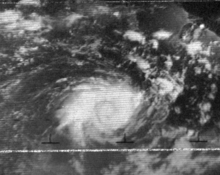
Back Zyklon Tracy German Tracy (tsüklon) Estonian Cyclone Tracy French Siklon Tracy ID Siklon Tracy Malay Cyklon Tracy Polish Ciclone Tracy Portuguese Трейси (циклон) Russian Cyclone Tracy SIMPLE Трейсі (циклон) Ukrainian
This article needs additional citations for verification. (March 2022) |
|name=. Remove this parameter; the article title is used as the name by default. Cyclone Tracy on Christmas Day 1974 | |
| Meteorological history | |
|---|---|
| Formed | 21 December 1974 |
| Dissipated | 26 December 1974 |
| Category 4 severe tropical cyclone | |
| 10-minute sustained (Aus) | |
| Highest winds | 175 km/h (110 mph) |
| Lowest pressure | 950 hPa (mbar); 28.05 inHg |
| Category 3-equivalent tropical cyclone | |
| 1-minute sustained (SSHWS/JTWC) | |
| Highest winds | 205 km/h (125 mph) |
| Overall effects | |
| Fatalities | 66 |
| Damage | $645 million (1974 USD) |
| Areas affected | Tiwi Islands, Northern Territory |
Part of the 1974–75 Australian region cyclone season | |
Severe Tropical Cyclone Tracy was a small tropical cyclone that devastated the city of Darwin, in the Northern Territory of Australia, in December 1974. The small, developing, easterly storm was originally expected to pass clear of the city, but it would turn towards it early on 24 December. After 10:00 p.m. ACST, damage became severe, with wind gusts reaching 217 km/h (117 kn; 135 mph) before instruments failed. The anemometer in Darwin Airport control tower had its needle bent in half by the strength of the gusts.[1]
Residents of Darwin were celebrating Christmas, and they did not immediately acknowledge the emergency, partly because they had been alerted to an earlier cyclone (Selma) which passed west of the city, not affecting it in any way. Additionally, news outlets had only a skeleton crew on duty over the holiday.
Tracy killed 66 people and caused $837 million in damage (1974 AUD, about $7.69 billion in 2022, approximately US$5.2 billion). It destroyed more than 70 percent of Darwin's buildings, including 80 percent of houses.[2][3] It left more than 25,000 out of the 47,000 inhabitants of the city homeless prior to landfall and required the evacuation of over 30,000 people,[4] of whom many never returned. After the storm passed, the city was rebuilt using more stringent standards "to cyclone code". The storm is the second-smallest tropical cyclone on record (in terms of gale-force wind diameter), behind only the North Atlantic's Tropical Storm Marco in 2008.[5]
- ^ "National Museum of Australia - Cyclone Tracy". www.nma.gov.au. Retrieved 10 January 2024.
- ^ "NT coroner hands down finding on Cyclone Tracy deaths". ABC News. 18 March 2005. Archived from the original on 5 April 2005. Retrieved 24 March 2006.
- ^ "Tropical cyclone extremes". Bureau of Meteorology. Archived from the original on 21 July 2015. Retrieved 19 July 2015.
- ^ "Event – Cyclone Tracy". Attorney-General’s Department Disasters Database. Australian Emergency Management Institute. Archived from the original on 26 April 2012. Retrieved 3 December 2011.
- ^ James L. Franklin (4 November 2008). "Tropical Cyclone Report: Tropical Storm Marco" (PDF). National Hurricane Center. Retrieved 23 January 2009.
© MMXXIII Rich X Search. We shall prevail. All rights reserved. Rich X Search